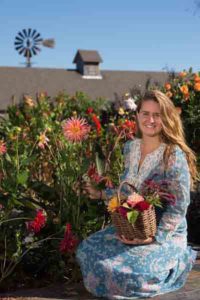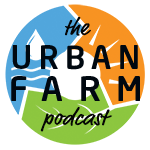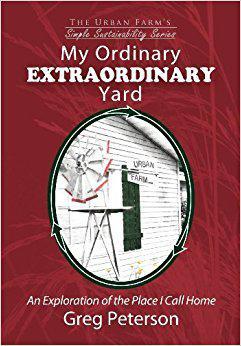314: Shannon McCabe on Gaining a Gardening Passion.
Finding amazing seeds and becoming a seed storyteller.
 Shannon is a writer, seed explorer and horticulturist for Baker Creek Heirloom Seed Company. After earning a degree in Environmental Horticulture from the University of Rhode Island, she worked on mixed-vegetable farms and a fruit orchard before starting her own small-scale farm on historic farmland.
She combined her life-long love of writing with her passion for farming when she began working as the farm manager and catalog writer for Baker Creek Heirloom Seeds.
Shannon is a writer, seed explorer and horticulturist for Baker Creek Heirloom Seed Company. After earning a degree in Environmental Horticulture from the University of Rhode Island, she worked on mixed-vegetable farms and a fruit orchard before starting her own small-scale farm on historic farmland.
She combined her life-long love of writing with her passion for farming when she began working as the farm manager and catalog writer for Baker Creek Heirloom Seeds.
Through co-writing the award winning Whole Seed Catalog, hosting instructional videos and dreaming up the Baker Creek children’s gardening book, she has enjoyed bringing the arcane heirloom vegetables of our past back to the foreground of the gardening discussion.Don’t miss an episode! Click here to sign up for weekly podcast updates
In This Podcast:
Her young life was spent on a small island near a 300-year-old farm, with a family that loved to share history through storytelling. Eventually, Shannon McCabe got a chance to work for Baker Creek seeds and now she documents the stories of seeds from around the world. Today, she explains what an heirloom seed is, and why they are special. She also shares a couple seed stories, including one for garden berries in Peru, and another about an ancient, crooknecked watermelon from a cave in Arizona. We cannot spoil this, you must listen for yourself!
Listen in and learn about:
- Growing up on a small island “Block Island” off coast of Rhode Island, and learning about farming from a 300 yr old farm
- Having a small plot on this farm for two years
- Getting a job at Bake Creek Seeds
- Starting her storytelling as a young kid
- Always wanting to be a writer
- The definition of an heirloom seed
- Her job at Baker creek allows her to research, grow, taste, and write the description of the seeds
- The story of the Ajvarksi, Sweet Pepper – https://www.rareseeds.com/ajvarski-sweet-pepper/
- Getting to travel around the world to find seeds and collect their stories
- Visiting to the Peruvian Amazon, looking for new garden berries
- Finding the cocona https://www.rareseeds.com/cocona/
- The most interesting seed story she has found in the entire time she has worked at Baker Seeds
- Ancient crookneck watermelon seeds found in basket in a cave in Arizona that they had to hunt down to find – this is an EPIC story you need to hear for yourself!!!
As well as:
- Her failure – A task to design a green house, but it was not a skill that she had
- Her success – Overcoming a fear of leaving her home town and traveling around the world
- Her drive – The stories! Sharing stories, cross culturally and within our families to encourage resiliency and diversity
- Her advice – Always ask questions, be inquisitive, then share; and always keep a journey
Shannon’s Book recommendations:

100 Vegetables and Where They Come from by Dr. William Wise Weaver
The Good Food Revolution: Growing Healthy Food, People, and Communities by Will Allen
How to reach Shannon:
Instagram: @seedscavenger
Email: seeds@rareseeds.com (attn: horticulture in subject line)
Facebook: @rareseeds
UrbanFarm.org/Shannon
Don’t miss an episode! Click here to sign up for weekly podcast updates




I want to pass this on. I am an old man, raised in the garden by depression people. I really don’t have anyone to pass this to.
You have a big platform, so you may be able to use this information. I would suggest you try it first, so you will be to say from experience just how you can raise so much more produce in so much less space.
As an example, plant a 4X4 space of any vegetable this way and another one the way you traditionally do. Then compare the results. It will help Baker Creek Seeds too. You will sell a lot more seeds after you see the results.
Plant the 4X4 very tightly. As the plants grow, thin them out. When you do, put the tiny plants in a blender, with water, grind them up and pour them back on the plants. To sum it up, the minerals and so forth, taken from the soil by a specific vegetable is only what you replace. Do this by using the same vegetable that took it out. Why add things that were never taken from the soil?
Things peppers take from the soil are not the same things that carrots take from it. Just think about it, then it will make academic sense to you. I have seen turnips the size of softballs. As the plants grow, every week or so, thin them out and put the compost back where it came from.
When the plants stop growing, put the compost in a compost pile. The results will surprise you.
Also, let the soil rest completely every 7th year. The Bible even says to do this. We need to rest, the soil does to. I suggest you plant for 5 years, the 6th year, use a plot for a compost plot, then let it rest the 7th year. The 6th year is not at rest because it is working on creating new soil. Then let it rest completely. This is not a waste of space. It may seek like it, but it will actually make a lot more produce over all with less space.
It won’t do any harm to try it, the credit is completely yours, my gift, is it works out.
It is easy, just grind the extra up in a blender so it will soak in quicker and easier and pour it on. After all, a blender is easy to clean, just put in clean water and turn it on, It cleans itself, Even pour that on the plants.
Thanks for this amazing information